If you do not have a backyard, then don’t let it stop you from your love of gardening. Here are the Best Windowsill Herbs you can grow without a garden!
Do you live in a studio apartment or condo and want to grow fresh aromatic herbs? But lack of space stops you? Well, if you have a got a balcony, you can start them there or on your windowsill–If it receives some sunlight.
Learn How to Make a Balcony Herb Garden here
Best Windowsill Herbs
1. Mint

Mint adds flavor to salads, cocktails, mocktails, yogurt, and a glass of lemonade. The flavor and the aroma that it adds to the food are incredibly versatile.
Soil: Use quality potting mix
Temperature: 65-80°F (18-27°C)
Water: Regular
Fertilizer: All-purpose liquid fertilizer once in 6 weeks in a weak dose
Health Benefits: Improves Irritable Bowel Syndrome (IBS), relieves indigestion, improves brain function, masks bad breath, and improves cold.
Check out our article on growing mint here
2. Oregano
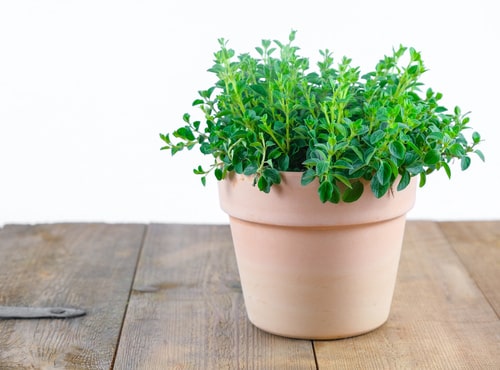
Oregano is a must-have for the Mediterranean, Italian, Middle Eastern, and Latin American cuisines. It is easy to care for and one of the best windowsill herbs you can grow.
Soil: Regular, well-draining soil, crumbly in texture
Temperature: 60-75°F (15-24°C)
Water: Moderate
Fertilizer: Once in 5-6 weeks
Health Benefits: Helps in treating asthma, cramps, diarrhea, aching muscles, indigestion, colds, and as an immunity booster.
Know everything about growing Oregano in Pots here
3. Chives
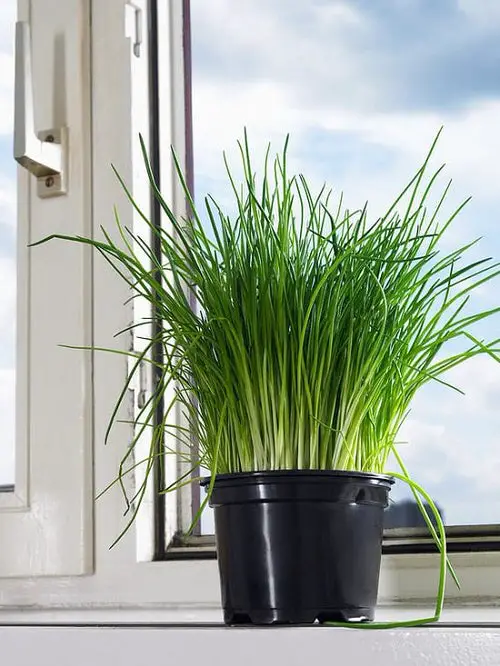
Adds an instant taste to eggs, soups, salads, potatoes, and most vegetable dishes. As long as it gets plenty of sunlight, it will continue to thrive.
Soil: Evenly moist
Temperature: 60-90 °F (15-32 °C)
Water: Regular
Fertilizer: Once in 6-8 weeks
Health Benefits: Common toppings for omelets, pasta, chicken dishes, soups, dips, fish, seafood dishes can improve memory and help in preventing cancer and osteoporosis.
Learn everything about Growing Chives In Pots here
4. Lemon Balm
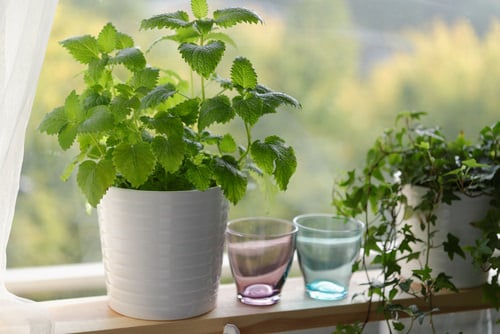
Another relative of Mint, Lemon Balm, has a strong, lemony flavor that lends a delicious taste to fish dishes, steamed and sauteed vegetables, sorbets, and fruit salads.
Soil: It does well in all types of soil
Temperature: 50-86°F (10-30°C)
Water: Regular
Fertilizer: Once in 4-5 weeks
Health Benefits: Besides culinary uses, lemon balm helps treat stress, depression, insomnia, indigestion, menstrual cramps, nausea, colds, and indigestion.
5. Parsley
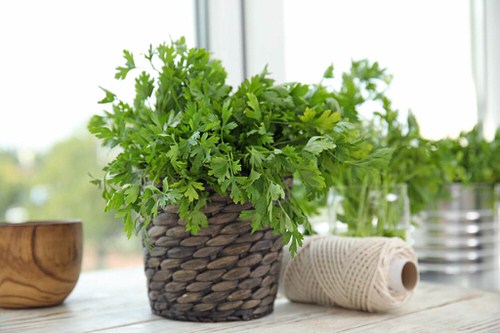
It adds flavor to stews, salads, sauces, soups. You can start growing your own by taking a cutting from an established plant.
Soil: Loamy, well-draining soil
Temperature: 50-95°F (10-35°C)
Water: When the topsoil feels dry to touch
Fertilizer: Once in 4-6 weeks
Health Benefits: Seeds, leaves, and roots can treat kidney stones, gastrointestinal issues, diabetes, asthma, high blood pressure, constipation, and bladder infections.
Here’s everything you need to know about growing parsley
6. Rosemary

Rosemary has a powerful fragrance that makes it a natural air freshener. It’s also a must-have seasoning for potatoes and savory meat dishes.
Soil: Grows best in light, well-draining soil
Temperature: 55 to 90°F (12-32°C)
Water: Regular, depending on the climate
Fertilizer: Once in 8 weeks
Health Benefits: Helps in improving memory, hair loss, indigestion, and arthritis-related joint pain.
Here’s all you need to know about growing rosemary
7. Thyme

There is a wide variety of Thyme that a gardener can choose from. It goes best with eggs, tomatoes, and chicken dishes. You can also use it to flavor cheese.
Soil: Well-drained, sandy
Temperature: 50-86°F (10-30°C)
Water: Water thoroughly when the topsoil feels dry
Fertilizer: Balanced fertilizer or aged manure once in 4-6 weeks
Health Benefits: Beneficial in swelling of the lungs (bronchitis), patchy hair loss, stomach disorders, and cough.
Check out our article on growing thyme here
8. Sage
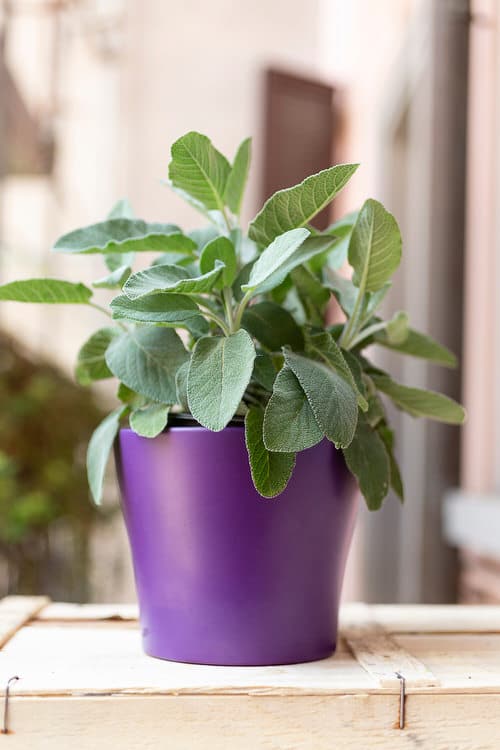
Sage is used in several delicacies using meat, cheese, and veggies—one of the herbs that can be quickly grown in a pot and with little care.
Soil: Well-drained and loamy.
Temperature: 50-80°F (10-27°C)
Water: When the topsoil feels dry to touch
Fertilizer: Add aged compost or well-rotted manure while planting
Health Benefits: Helpful in easing digestive problems and loss of appetite, stomach pain, diarrhea, heartburn, and bloating. It is also used for memory loss, depression, and Alzheimer’s disease.
Here’s everything you need to know about growing sage
9. Cilantro
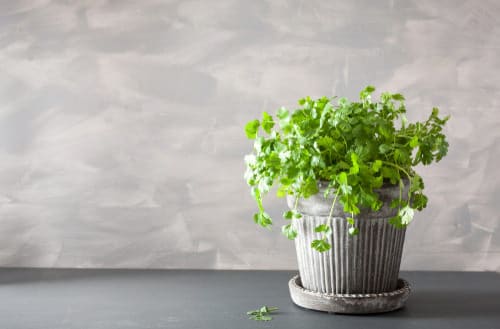
It adds a unique flavor to the Indian subcontinent and Mexican dishes such as soups and stews. It also makes for a wonderful addition to chutney, dips, and dressings.
Soil: Neutral soil, rich in organic matter
Temperature: 50-100°F (10-38°C)
Water: Regular
Fertilizer: Half-strength nitrogen-rich fertilizer once a month.
Health Benefits: Measles, cancer, toothache, prevents urinary tract infections, lowers blood sugar levels, reduces anxiety, improves sleep, and protects against food poisoning.
Check out our article on growing Cilantro here
10. Basil

Whether it’s sandwiches, marinades, Italian cuisine, Pesto, or any sauces, there is no such dish that a dash of basil cannot make taste better, and many of you would agree!
Soil: Well-draining, moist soil.
Temperature: 70-90 °F (22-32 °C)
Water: Regular
Fertilizer: Once in 7-8 weeks
Health Benefits: Helps in treating loss of appetite, intestinal gas, head colds, warts, stomach spasms, treat snake and insect bites.
Have a look at our article on growing Basil here
11. Chervil

Chervil or the French Parsely is a staple in French cuisine and makes for a tasty complement to fish, steamed/sauteed veggies, and eggs.
Soil: Quality potting mix
Temperature: 54-77°F (12-25°C)
Water: Regular
Fertilizer: Add aged compost or well-rotted manure during planting
Health Benefits: The leaves and dried parts of the flower are used to cure cough, help ease digestion disorders, high blood pressure, fluid retention, gout, abscesses, and eczema.


